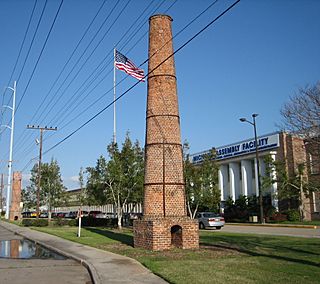Michoud, New Orleans facts for kids
Quick facts for kids
Michoud, Louisiana
|
|
|---|---|

Old plantation smokestacks stand outside the administration offices of NASA's Michoud Assembly Facility, c.2006.
|
|
| Country | United States |
| State | Louisiana |
| Parish | Orleans |
| Area | |
| • Total | 349.85 sq mi (906.10 km2) |
| • Land | 169.50 sq mi (439.00 km2) |
| • Water | 180.35 sq mi (467.10 km2) |
| Elevation | -3 ft (−0.9 m) |
| Population
(2020)
|
|
| • Total | 383,997 |
| • Density | 2,265.48/sq mi (874.71/km2) |
| Time zone | UTC-6 (Central (CST)) |
| • Summer (DST) | UTC-5 (CDT) |
| Area code(s) | 504 |
| GNIS feature ID | 543467 |
| FIPS code | 22-55000 |
Michoud (pronounced MEE-shoo) is a special area in Eastern New Orleans, Louisiana. It's part of the Ninth Ward of New Orleans. Michoud is known for its important history and its connection to space exploration.
Contents
Michoud's Past: A Sugar Plantation
Michoud started as a small farming village in the 1800s. It was named after Antoine Michoud, a French sugar farmer. He bought a large piece of land in 1827. This land was originally given to a local merchant by the French king.
Antoine Michoud grew sugar cane and processed it into sugar. He ran his sugar plantation and refinery until he passed away in 1863. His family kept the business going for many years. Today, you can still see two old brick smokestacks from his original sugar refinery. They stand as a reminder of Michoud's early days.
Growing into an Industrial Hub
Over time, Michoud began to change. When the Gulf Intracoastal Waterway was built, it helped industry grow. This waterway made it easier to transport goods.
During World War II, Michoud became very important for the military. Factories like those run by Higgins Industries were built here. They made things needed for the war effort. A small airfield was also built in the 1940s and 1950s.
Michoud and Space Exploration
In the 1960s, Michoud became famous for its role in space. The airfield was mostly removed, but the large factory buildings remained. NASA took over these factories for the moon program.
Today, this site is known as the NASA Michoud Assembly Facility. It's where huge parts of rockets and spacecraft are built. This includes parts for the Space Shuttle and the new Space Launch System. It's a key place for America's journey into space!
Michoud's Unique Location
Michoud is in a very low-lying area. It's actually one of the lowest spots in New Orleans. This area is also sinking faster than many other places in Louisiana.



